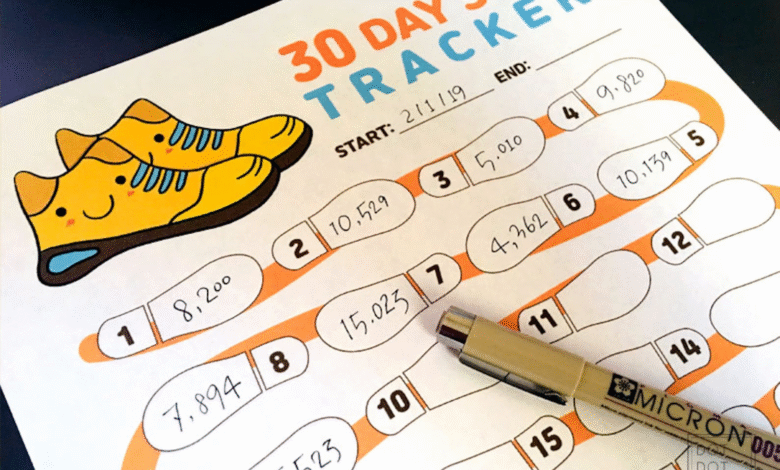Daily Step Count: Just 7,000 Steps for Better Health

Daily step count is a crucial metric for those looking to enhance their health and well-being. Recent findings suggest that aiming for just 7,000 steps a day can significantly reduce the risk of death and improve various health markers, including heart disease, diabetes, and mental health issues. This shift away from the traditional 10,000-steps benchmark not only makes daily movement more attainable but also emphasizes the health benefits of walking. By integrating manageable steps into our routines, we can increase daily movement and pave the way to better health outcomes. Embracing a lifestyle with adequate walking not only promotes physical fitness but also contributes to a longer, healthier life.
The concept of measuring your daily step tally is becoming increasingly important for maintaining health. Walking for health has long been celebrated for its many advantages, and new research highlights that setting a target of 7,000 steps daily may be sufficient to foster significant health improvements. This approach encourages individuals to think about their overall activity levels and find practical ways to incorporate more movement into their lives, such as taking the stairs or walking short distances instead of driving. By focusing on consistent, achievable step counts, people can better manage their risk of chronic conditions while boosting their overall vitality. Aiming for this moderate daily movement not only enhances physical fitness but also cultivates a healthier lifestyle.
The Health Benefits of Walking 7,000 Steps a Day
Walking is one of the simplest yet most effective forms of exercise, and recent research highlights that achieving a daily step count of 7,000 can yield significant health benefits. This moderate step goal is associated with a 47% reduction in the risk of death from various chronic diseases, including heart disease and certain types of cancer. Increasing your step count to this level can improve your cardiovascular health, lower the incidence of type 2 diabetes, and bolster cognitive function, showcasing that walking just a few thousand steps daily can be transformative for overall health.
According to studies conducted by researchers at the University of Sydney, individuals who increase their daily walking to 7,000 steps can experience substantial health improvements, particularly those transitioning from very low activity levels. Even modest increases, such as moving from 2,000 to 4,000 steps, have been shown to provide health gains. This research emphasizes that every step counts, suggesting that even small adjustments in daily routine can lead to more active lifestyles and mitigate health risks.
How Daily Step Count Affects Mental Health
Regular walking, particularly hitting a target like 7,000 steps daily, has a positive impact on mental health. The physical activity associated with walking releases endorphins, which can alleviate feelings of anxiety and depression. Additionally, engaging in regular walking routines has been linked to lower levels of cognitive decline, reinforcing the connection between physical activity and mental well-being. By improving mood and reducing stress, walking serves as a simple yet effective tool for mental health maintenance.
Moreover, walking is not solely beneficial for enhancing mood; it can also play a critical role in combating depression and anxiety disorders. According to findings from the University of Sydney study, participants who achieved a daily step count of at least 7,000 reported fewer depressive symptoms. This illustrates the importance of incorporating walking into daily life—not just for physical health—but as a holistic approach to improving psychological wellness.
Integrating Walking into Your Daily Routine
Incorporating walking into your routine doesn’t have to be a chore. Simple changes like taking the stairs instead of elevators or parking further from store entrances can contribute to your daily step goal. These strategies promote an increase in daily movement without requiring dedicated workout times, thus making it easier to achieve the recommended 7,000 steps per day. Moreover, casual, incidental walking can add up over the course of a day, ultimately benefitting your health and well-being.
Additionally, consider setting small, achievable goals that gradually increase your walking distance. For example, start by walking 3,000 steps a day and gradually increasing to 7,000 steps. Using pedometers or smartphone apps can help track your progress and motivate you to stay active. Embracing a walking culture—whether it’s through group walks with friends or participating in community walking events—can provide social benefits and encourage consistent daily movement.
The Role of Strength Training in Conjunction with Walking
While walking is beneficial on its own, the incorporation of strength training can enhance overall health even further. Combining these two forms of exercise is believed to optimize health benefits, enhancing muscle strength, and boosting metabolism. Researchers emphasize that while achieving a daily step count of 7,000 is essential, incorporating a variety of physical activities—including resistance-based exercises—can yield comprehensive health improvements across multiple facets.
Engaging in strength training alongside regular walking not only builds muscle but also helps to prevent falls, improve balance, and maintain bone density as one ages. Thus, a balanced routine that integrates both activities is recommended for optimal health benefits. This approach not only reduces the risk of chronic diseases associated with inactivity but also helps in enhancing functional fitness, ultimately promoting a better quality of life.
Strategies for Increasing Your Daily Step Count
Increasing your daily step count can be simpler than you think. One effective strategy is to establish a routine that includes walking at specific times each day, such as during lunch breaks or after dinner. This can help to embed the habit of walking into your daily life while providing a structured means to achieve your 7,000-step goal. Utilizing walking meetings at work or opting for a walking route while catching up with friends can also make the process enjoyable.
Moreover, participating in community initiatives, like charity walks or local walking groups, can provide an added motivational boost. These activities not only foster a sense of community but also create opportunities for social engagement while promoting increased daily movement. Finding ways to make walking a fun and social affair can lead to achieving and surpassing your daily step count.
Understanding the Science Behind Walking and Health
The correlation between daily walking and various health benefits is grounded in scientific research that indicates how physical activity impacts different physiological systems. Walking, as a weight-bearing exercise, strengthens bones, improves cardiovascular health, and enhances metabolic function. Research underscored that even slight increases in daily step counts—such as aiming for 7,000—can provide measurable health advantages, laying the foundation for future wellness initiatives.
Furthermore, studies have demonstrated that consistent walking routines can lead to a lower incidence of serious health issues like heart disease and diabetes. The peer-reviewed evidence, including data analyzed from 57 studies, confirms the hypothesis that regular movement can substantially decrease mortality risk. Understanding these scientific underpinnings can empower individuals to take their health into their own hands through walking and other forms of physical activity.
Setting Realistic Goals for Daily Steps
Setting an achievable daily target for step counts can serve as a motivational tool for individuals seeking to improve their health. The recent findings suggest that targeting 7,000 steps as a practical goal may be more sustainable than the previously recommended 10,000 steps. This realistic target allows individuals at different fitness levels to adjust their activities and aim for something attainable, thus fostering a positive relationship with physical activity.
For those who find themselves falling short of their goals, it’s essential to remember that every increase in daily steps can yield health benefits. Taking gradual steps towards reaching the 7,000 mark can help mitigate feelings of frustration and promote a healthier lifestyle. By celebrating small achievements along the way, individuals can build confidence and embrace their journey towards improved health.
Walking: A Cost-Effective Fitness Solution
Walking is an incredibly accessible form of exercise that requires no special equipment or gym membership, making it a cost-effective approach to fitness. This activity can be performed almost anywhere and at any time, allowing individuals to seamlessly integrate walking into their daily lives. Whether it’s a stroll around the neighborhood or a brisk pace through a local park, walking fits into virtually any schedule or budget.
Additionally, walking provides a unique opportunity to connect with nature and enjoy scenic surroundings, which can enhance the overall experience. By adopting walking as a primary mode of exercise, individuals can significantly enhance their physical and mental health without the financial burden often associated with other fitness activities. This affordability not only makes walking appealing but also encourages long-term adherence to an active lifestyle.
The Importance of Community in Walking Initiatives
Community plays a vital role in promoting healthy practices such as walking. Local walking groups, community challenges, and organized events can motivate individuals to step up their daily counts. Engaging with others who share the same health goals fosters accountability and can transform walking from a solitary activity into a social affair. These communal initiatives can spur friendly competition and reinforce the commitment to maintaining physical activity.
Moreover, communities that prioritize walkability through the development of safe parks and walking paths encourage residents to engage more in physical activities. By making environment-friendly choices that support walking, local governments can significantly influence public health outcomes. Collective efforts to create a culture surrounding walking not only improve the community’s health but also encourage greater participation in achieving a daily step count of 7,000 or more.
Exploring the Link Between Walking and Chronic Disease Prevention
Research conclusively shows that regular walking significantly lowers the risk of chronic diseases, particularly when individuals achieve a step count of around 7,000 per day. The data indicates that engaging in walking can substantially decrease the risks of heart disease and certain types of cancer, directly relating to improved cardiovascular health and metabolic function. With consistent engagement in this simple activity, the mechanisms behind these health improvements become apparent.
By walking regularly, individuals not only enhance cardiovascular endurance but also promote better blood flow and oxygen delivery throughout the body. This can result in lower blood pressure, improved cholesterol levels, and better blood glucose control. Notably, those who maintain a target of 7,000 steps per day take significant strides towards preventing chronic illnesses, drawing a direct correlation between daily movement and health longevity.
Frequently Asked Questions
What is the ideal daily step count for health benefits?
Recent research indicates that aiming for a daily step count of 7,000 steps can significantly enhance health outcomes. This target is linked to a 47% reduction in the risk of death and improvements in conditions such as heart disease, type 2 diabetes, and dementia.
How can increasing my daily step count impact my health?
Increasing your daily step count, even modestly, can lead to considerable health improvements. For instance, moving from 2,000 to 4,000 steps a day is associated with significant health gains, and striving for 7,000 steps per day is recommended for optimal benefits.
Is 10,000 steps still the recommended daily goal?
While 10,000 steps has been a popular benchmark for daily movement, new studies suggest that 7,000 steps per day may be sufficient for health benefits, including a reduction in the risk of chronic diseases and improved overall health.
What are the health benefits of walking 7,000 steps a day?
Walking at least 7,000 steps daily is associated with reduced risks of heart disease, type 2 diabetes, dementia, and even depression. This level of activity contributes to better health markers and overall longevity.
Can I achieve health benefits through daily movement apart from walking?
Absolutely! Daily movement isn’t limited to walking. Everyday activities such as taking the stairs, gardening, or walking to the bus stop can contribute to your step count and enhance your health.
How significant is the step count in reducing the risk of death?
Research shows that aiming for 7,000 steps a day can lower the risk of death by 47%, making it a vital target for maintaining health and longevity.
If I can’t reach 7,000 steps, what should I do?
If you find it challenging to reach 7,000 steps, aim to gradually increase your daily step count. Even minor increases, such as from 2,000 to 4,000 steps, can result in meaningful health improvements.
Are there specific strategies to increase my daily step count?
Yes! Incorporate small lifestyle changes like parking further away, using the stairs instead of elevators, or breaking up walking into short bursts throughout the day to increase your daily step count effortlessly.
| Key Point | Details |
|---|---|
| Research Findings | Walking 7,000 steps daily can reduce the risk of death by 47%, akin to walking 10,000 steps. |
| Health Improvements | 7,000 steps linked to benefits for heart disease, diabetes, dementia, and depression. |
| Incremental Benefits | Even modest increases from 2,000 to 4,000 steps yield health gains. |
| Exercise Recommendations | Incorporate strength training and mobility exercises along with increased step counts. |
| Everyday Movement | Daily activities like taking stairs or walking a bit more contribute to health. |
Summary
The daily step count is vital for maintaining good health, and recent research suggests that walking just 7,000 steps daily is more beneficial than the old 10,000-step goal. This new understanding emphasizes that even small increases in activity can lead to significant health improvements, particularly in reducing the risk of chronic diseases and mortality. In essence, aiming for 7,000 steps is a realistic and achievable target that can enhance your overall well-being.




